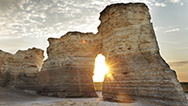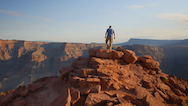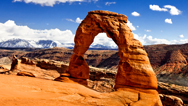These Boulders are Alive
- By Ana Aceves
- Posted 08.23.18
- NOVA
Containing key clues to the evolution of virtually all complex life, stromatolites––underwater mounds of up to eight feet tall––are created by one of the oldest organisms on our planet. Over thousands of years, layers of mud and sand accumulated to build these structures, which are coated in a thin layer of bacteria. Today, growing stromatolites are extremely rare to find.
Transcript
These Boulders Are Alive
Published August 23, 2018
Kirk Johnson: We’re looking for one of the oldest organisms on our planet but as we descend, there’s not much sign of life. Could it be hiding behind these strange rocks?
Actually, these rocks are the very things that I’ve come to see. They’re called stromatolites…and believe it or not, they’re alive.
You can’t see them, but just beneath the surface of these boulders is a thin coating of bacteria. Over thousands of years, these microbes accumulated—layer after layer of mud and sand—to build mounds up to 8 feet tall. Today, living, growing stromatolites like these are extremely rare, but these precious examples hold the key to the evolution of virtually all complex life.
I could stay down here for hours, but the current is getting stronger and we don’t want to get pulled out to sea.
That was amazing down there. The current really picked up. It was ripping through there, too.
Pamela Reid: And that is actually one important reason for why we have these stromatolites.
Johnson: What’s special about this spot that allows them to be here?
Reid: Well, you noticed a very strong current when we were there, and you also noticed there were sand waves that were going over the stromatolites. That sand will actually bury the stromatolites for months at a time.
Johnson: And then unbury them again?
Reid: And unbury them again. And then that burial is really important to the existence of the stromatolites.
Johnson: When the sand is swept away, the stromatolites are vulnerable to seaweed and corals that block the sun. The sand protects them.
Reid: It keeps away the higher organisms. The seaweeds, the corals. In early Earth, there were no corals and seaweeds to compete, so they actually had a much bigger territory and they dominated the planet for about 80% of Earth history. Stromatolites were kings.
Credits
PRODUCTION CREDITS
- MAKING NORTH AMERICA: LIFE
- Produced and Directed by
- Gwyn Williams
- Series Producer
- Peter Oxley
- Digital Producer
- Ana Aceves
- Editorial Review
- Julia Cort
- © WGBH Educational Foundation 2018
Related Links
-

Making North America: Life
How did massive volcanic eruptions, inland seas, and land bridges pave the way for life?
-

Time Travel in the Grand Canyon
What does this geological wonder reveal about North America’s deep history?
-

What on Earth Made This?
In this geology quiz, test your knowledge of forces that shape beautiful and bizarre natural formations on our planet.
-

Life's Rocky Start
What is the secret link between rocks and minerals, and every living thing on Earth?

